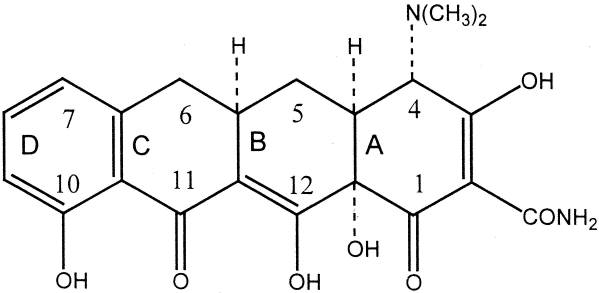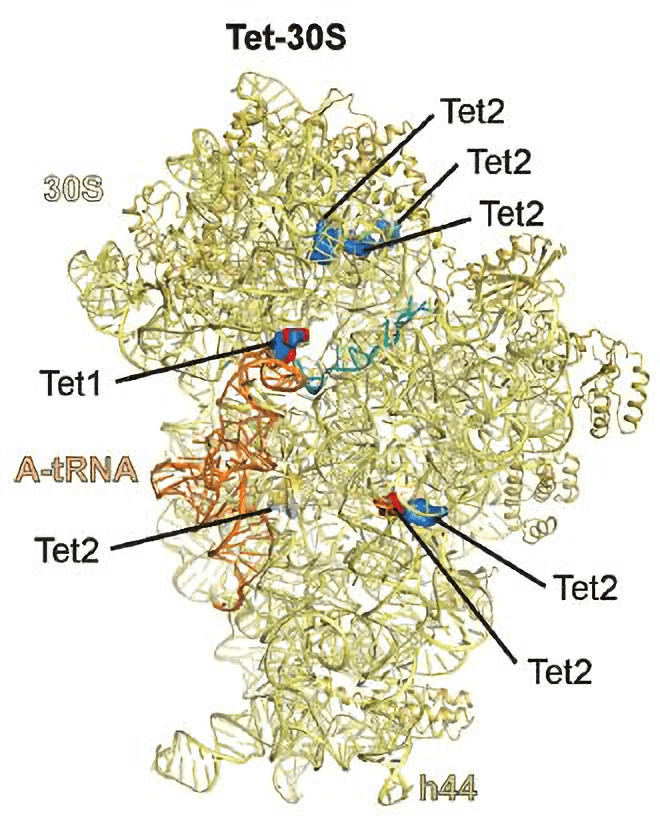Tetracyclines
There is a long history of using antibiotics to kill bacteria and treat infection disease, and the antibiotics have made a significant contribution to human health. However, some bacteria have evolved resistant to commonly used antibiotics and have posed a greater health threat. Fortunately, a novel therapeutic strategy, antibody-antibiotic conjugate (AAC), is showing its superiority in antibiotic-resistant bacteria controlling. With enriched experience and profession scientist team, Creative Biolabs offers comprehensive customized design and synthesis service of tetracycline-linker to proceed your AACs development strategies.
Introduction
Tetracyclines are normally used against the infections of the urinary tract, respiratory tract, and the intestines. They are also used in the treatment of chlamydia, for patients who are allergic to β-lactams and macrolides. The most general using of Tetracycline derivatives (including tetracycline, oxytetracycline, doxycycline or minocycline) is in the treatment of moderately severe acne and rosacea. Doxycycline is effectively used as a prophylactic treatment for Bacillus anthracis (anthrax) and Yersinia pestis infection. It is also effective in treating malaria, prophylaxis and elephantitis filariasis. Tetracyclines also are useful for the treatment of chlamydia, Rickettsia, brucellosis and spirochetal infections. In addition, they can be applied to the treatment of anthrax, plague, tularemia and Legionnaires’ disease, as well as the alleviating the duration and severity of cholera.

Fig.1 Structure of 6-deoxy-6-demethyltetracycline, the minimum tetracycline pharmacophore. (Chopra, 2001)
Mode of Action of Tetracyclines
Tetracycline antibiotics inhibit protein synthesis of bacteria by inhibiting the binding of aminoacyl-tRNA to the mRNA-ribosome complex. Namely, they can bind to the 30S ribosomal subunit within the mRNA translation complex. Tetracyclines also have been found to hinder matrix metalloproteinases. This mechanism has led to extensive research on chemically modified tetracyclines or CMTs (the tetracycline derivatives) to treat rosacea, acne, diabetes and various types of neoplasms. Several trials have examined modified and unmodified tetracyclines for the treatment of human cancers, results indicated that it was promising with CMT-3 for patients with Kaposi Sarcoma.

Fig.2 Binding site of tetracyclines on the ribosome. Primary (Tet1) and secondary (Tet2) binding sites of tetracycline on the 30S subunit, termed the ‘primary binding site’ (Tet1), which is located at the base of the head of the 30S subunit. The identification of multiple lower occupancy secondary binding sites (Tet2) indicated that tetracyclines have multiple binding sites on the small and large subunit. (Nguyen, 2014)
Tetracyclines-based AACs
Tetracyclines are a potent drug used in the treatment of bacterial infection. At present, AACs using tetracyclines as payloads linked with exclusive monoclonal antibody to optimize therapeutic schedule are under active development. In brief, the specific targeting capability of a monoclonal antibody enables the delivery of tetracyclines exclusively to the infection site, which can reduce collateral damage to the normal tissues. After bacterial antigen binding, the tetracyclines-based AACs will be internalized via receptor-mediated endocytosis and the drug payload is released to kill bacteria in the infection site.
Scientists at Creative Biolabs have decade years’ experience in antibody/protein conjugation, and now we are committed to helping customers develop their own AACs by using tetracyclines as payloads. We believe that our professional scientist team and advanced technology platforms can greatly contribute to your research and projects in a time-saving and cost-efficient manner. Please feel free to contact us for more information and a detailed quote.
References
- Chopra, I. (2001) "Tetracycline antibiotics: mode of action, applications, molecular biology, and epidemiology of bacterial resistance." Microbiology and molecular biology reviews, 65(2), 232-260.
- Nguyen, F.; et al (2014). “Tetracycline antibiotics and resistance mechanisms”. Biological Chemistry, 395(5), 559.
For Research Use Only. NOT FOR CLINICAL USE.
Related Sections
Antibody-antibiotic Conjugate (AAC): Services:
Welcome! For price inquiries, please feel free to contact us through the form on the left side. We will get back to you as soon as possible.
Contact usUSA
Tel:
Fax:
Email:
Europe
Tel:
Email:
Germany
Tel:
Email:

